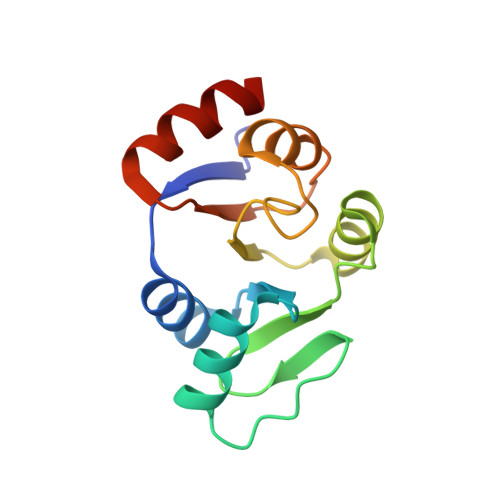Two Binding Sites of SARS-CoV-2 Macrodomain 3 Probed by Oxaprozin and Meclomen.
Li, J., Zhong, F., Li, M., Liu, Y., Wang, L., Liu, M., Li, F., Zhang, J., Wu, J., Shi, Y., Zhang, Z., Tu, X., Ruan, K., Gao, J.(2022) J Med Chem 65: 15227-15237
- PubMed: 36356292
- DOI: https://doi.org/10.1021/acs.jmedchem.2c01168
- Primary Citation of Related Structures:
7XC3, 7XC4 - PubMed Abstract:
Severe acute respiratory syndrome-coronavirus-1/2 (SARS-CoV-1/2) macrodomain 3 (Mac3) is critical for replication and transcription of the viral genome and is therefore a potential therapeutic target. Here, we solved the crystal structure of SARS-CoV-2 Mac3, which reveals a small-molecule binding pocket. Two low-molecular-weight drugs, oxaprozin and meclomen, induced different patterns of nuclear magnetic resonance (NMR) chemical shift perturbations (CSPs). Meclomen binds to site I of SARS-CoV-2 Mac3 with binding pose determined by NMR CSP and transferred paramagnetic relaxation enhancement, while oxaprozin binds to site II as revealed by the crystal structure. Interestingly, oxaprozin and meclomen both perturb residues in site I of SARS-CoV Mac3. Fluorescence polarization experiments further demonstrated that oxaprozin and meclomen inhibited the binding of DNA-G4s to SARS-CoV-2 Mac3. Our work identified two adjacent ligand-binding sites of SARS-CoV-2 Mac3 that shall facilitate structure-guided fragment linking of these compounds for more potent inhibitors.
Organizational Affiliation:
Ministry of Education Key Laboratory for Membrane-less Organelles & Cellular Dynamics, Biomedical Sciences and Health Laboratory of Anhui Province, Division of Life Sciences and Medicine, University of Science and Technology of China, Hefei230027, Anhui, P. R. China.

















